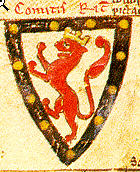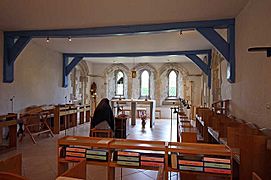Burnham Abbey facts for kids

Burnham Abbey with the present chapel on the right
|
|
| Monastery information | |
|---|---|
| Full name | The Abbey of St Mary the Virgin at Burnham |
| Order | Augustinian Canonesses |
| Established | 1266 |
| Disestablished | 1539 |
| Dedicated to | Virgin Mary |
| Diocese | Lincoln |
| People | |
| Founder(s) | Richard, Earl of Cornwall, King of the Romans, |
| Site | |
| Location | Burnham, Buckinghamshire, England |
| Visible remains | chapter house, sacristy, parts of the frater and infirmary |
Burnham Abbey was once a home for Augustinian canonesses regular, which are like nuns who follow the rules of Saint Augustine. It is located near Burnham in Buckinghamshire, England. A powerful person named Richard, Earl of Cornwall started the abbey in 1266.
The abbey, dedicated to St Mary, began with about twenty nuns. It was never a very rich place. By the time it closed in 1539, only ten nuns lived there. Since 1916, the old buildings have been used by a group of Anglican nuns called the Society of the Precious Blood. They still call the place "Burnham Abbey."
The Abbey's Early Days
Burnham Abbey was founded in 1265 or 1266. Its founder was Richard, Earl of Cornwall. He was the brother of King Henry III and was also known as the King of the Romans. Richard gave the abbey several pieces of land. This included the manor of Burnham and land near Cippenham. This land came with a mill, a fishing area, and other rights.
The abbey was built about half a mile from Burnham village. Soon after it was built, some people complained. They said Richard had moved a water stream that a nearby village used. They also said he gave 20 acres (about 81,000 square meters) of common land to the abbey. We don't know if this problem was ever fixed.
In 1311, a nun named Margery of Hedsor left the monastery. She also broke her vows. Because of this, she was officially removed from the church community. This punishment was repeated for several years. Then, for unknown reasons, the Bishop cancelled it.
In 1330, there was a big legal argument. It was about who owned the manor of Bulstrode. This land had been given to the abbey. But a man named Geoffrey de Bulstrode claimed it was his. To show his anger, he damaged the abbey's property. He also bothered the nuns' workers. In the end, a group decided the abbey was the rightful owner. However, the abbey had already lost a lot of money and property.
When the Abbey Closed
Burnham Abbey did not have many valuable things. Because of this, it should have been closed in 1536. This was during the first wave of the Dissolution of the Monasteries. This was when King Henry VIII closed many monasteries in England.
However, local officials asked for the abbey to stay open. This delayed its closing until 1539. The document that officially closed the abbey was signed on September 19, 1539. It was signed by Alice Baldwin, who was the Abbess (the head nun). The nine other nuns also signed it. There were also two priests living there.
When the abbey closed, its yearly income was about £51. The Abbess, Alice Baldwin, was given a small payment each year. She seems to have spent her last years living in Aylesbury. She stayed at the home of her father, Sir John Baldwin. He was a very important judge at the time.
What Happened Next
In 1544, the abbey's land was given to William Tyldesley. He was a servant in the King's court. In 1574, Queen Elizabeth gave the property to Paul Wentworth. He had married William Tyldesley's widow, Helen. In 1569, a nobleman named Thomas Howard, 4th Duke of Norfolk, was held at the abbey. He was later sent to the Tower of London.
Around 1570, the abbey's church was pulled down. A house was made from many of the remaining buildings. By 1719, the site was being used as a farm. Some of the old buildings, like the refectory (dining hall), were in bad shape.
In 1913, an architect named James Lawrence Bissley bought the property. He fixed up the remaining buildings. He even turned the old chapter house (where the nuns met) into a chapel. In 1916, he sold the property to the Society of the Precious Blood. This is a group of Anglican Augustinian nuns. They moved in and began to fix and expand the abbey for their own use.
Today, Burnham Abbey is a Grade I listed building. This means it is a very important historical building. The walls and other structures around it are Grade II listed. Parts of the medieval nunnery still remain. These include the chapter house, the sacristy (a room for sacred items), and parts of the frater (dining hall) and infirmary (sick room).
Gallery





